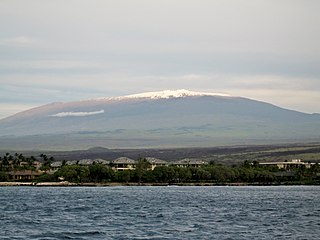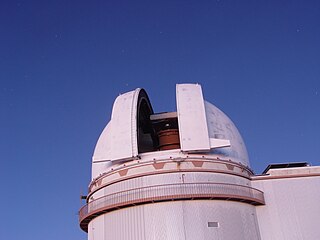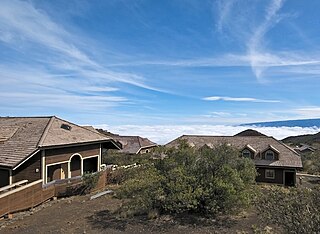
Gordon Earle Moore was an American businessman, engineer, and the co-founder and emeritus chairman of Intel Corporation. He proposed Moore's law which makes the observation that the number of transistors in an integrated circuit (IC) doubles about every two years.

The W. M. Keck Observatory is an astronomical observatory with two telescopes at an elevation of 4,145 meters (13,600 ft) near the summit of Mauna Kea in the U.S. state of Hawaii. Both telescopes have 10 m (33 ft) aperture primary mirrors, and, when completed in 1993 and 1996, they were the largest optical reflecting telescopes in the world. They are currently the third and fourth largest.

Mauna Kea is an inactive volcano on the island of Hawaiʻi. Its peak is 4,207.3 m (13,803 ft) above sea level, making it the highest point in Hawaii and second-highest peak of an island on Earth. The peak is about 38 m (125 ft) higher than Mauna Loa, its more massive neighbor. Mauna Kea is unusually topographically prominent for its height: its wet prominence is fifteenth in the world among mountains, at 4,205 m (13,796 ft); its dry prominence is 9,330 m (30,610 ft). This dry prominence is greater than Mount Everest's height above sea level of 8,848.86 m (29,032 ft), and some authorities have labeled Mauna Kea the tallest mountain in the world, from its underwater base. Mauna Kea is ranked 8th by topographic isolation.

The Mauna Kea Observatories (MKO) are a group of independent astronomical research facilities and large telescope observatories that are located at the summit of Mauna Kea on the Big Island of Hawaiʻi, United States. The facilities are located in a 525-acre (212 ha) special land use zone known as the "Astronomy Precinct", which is located within the 11,228-acre (4,544 ha) Mauna Kea Science Reserve. The Astronomy Precinct was established in 1967 and is located on land protected by the Historical Preservation Act for its significance to Hawaiian culture. The presence and continued construction of telescopes is highly controversial due to Mauna Kea's centrality in native Hawaiian religion and culture, as well as for a variety of environmental reasons.

The Gemini Observatory comprises two 8.1-metre (26.6 ft) telescopes, Gemini North and Gemini South, situated in Hawaii and Chile, respectively. These twin telescopes offer extensive coverage of the northern and southern skies and rank among the most advanced optical/infrared telescopes available to astronomers. (See List of largest optical reflecting telescopes).

The Thirty Meter Telescope (TMT) is a planned extremely large telescope (ELT) that has become controversial due to its location on Mauna Kea, on the island of Hawaiʻi. The TMT would become the largest visible-light telescope on Mauna Kea.

A segmented mirror is an array of smaller mirrors designed to act as segments of a single large curved mirror. The segments can be either spherical or asymmetric. They are used as objectives for large reflecting telescopes. To function, all the mirror segments have to be polished to a precise shape and actively aligned by a computer-controlled active optics system using actuators built into the mirror support cell.

The University of Hawaiʻi 88-inch (2.24-meter) telescope—called UH88, UH2.2, or simply 88 by members of the local astronomical community—is situated at the Mauna Kea Observatories and operated by the University's Institute for Astronomy. It was constructed in 1968, and entered service in 1970, at which point it was known as "The Mauna Kea Observatory". It became one of the first professional telescopes to be controlled by a computer. The telescope was built with funding from NASA, to support Solar System missions, and is controlled by the University of Hawaiʻi. The success of the telescope helped demonstrate the value of Mauna Kea for astronomical observations.

Alexei Vladimir "Alex" Filippenko is an American astrophysicist and professor of astronomy at the University of California, Berkeley. Filippenko graduated from Dos Pueblos High School in Goleta, California. He received a Bachelor of Arts in physics from the University of California, Santa Barbara in 1979 and a Ph.D. in astronomy from the California Institute of Technology in 1984, where he was a Hertz Foundation Fellow. He was a postdoctoral Miller Fellow at Berkeley from 1984 to 1986 and was appointed to Berkeley's faculty in 1986. In 1996 and 2005, he a Miller Research Professor, and he is currently a Senior Miller Fellow. His research focuses on supernovae and active galaxies at optical, ultraviolet, and near-infrared wavelengths, as well as on black holes, gamma-ray bursts, and the expansion of the Universe.

An extremely large telescope (ELT) is an astronomical observatory featuring an optical telescope with an aperture for its primary mirror from 20 metres up to 100 metres across, when discussing reflecting telescopes of optical wavelengths including ultraviolet (UV), visible, and near infrared wavelengths. Among many planned capabilities, extremely large telescopes are planned to increase the chance of finding Earth-like planets around other stars. Telescopes for radio wavelengths can be much bigger physically, such as the 300 metres aperture fixed focus radio telescope of the Arecibo Observatory. Freely steerable radio telescopes with diameters up to 100 metres have been in operation since the 1970s.
Howard Brighton Keck was an American businessman. He was also a Thoroughbred racehorse owner and breeder, and the owner of an auto racing team that twice won the Indianapolis 500.

The Onizuka Center for International Astronomy, also known as Hale Pōhaku, is a complex of support facilities for the telescopes and other instruments that comprise the Mauna Kea Observatory atop Mauna Kea, on Hawaiʻi island.
Jerry Earl Nelson was an American astronomer known for his pioneering work designing segmented mirror telescopes, which led to him sharing the 2010 Kavli Prize for Astrophysics.

Charles Mattias ("Matt") Mountain is currently the President of the Association of Universities for Research in Astronomy (AURA) which designs, builds, and operates telescopes and observatories for the National Science Foundation (NSF) and the National Aeronautics and Space Administration (NASA). AURA's NASA center is the Space Telescope Science Institute (STScI), responsible for the science mission for the Hubble Space Telescope, the science and operations for the James Webb Space Telescope, and the MAST data archive. AURA's NSF centers are Gemini Observatory, the National Optical Astronomy Observatory (NOAO), and the National Solar Observatory (NSO). Dr. Mountain and AURA are also responsible for the NSF construction projects: the Daniel K. Inouye Solar Telescope (DKIST) on Haleakalā, Hawaii and the Large Synoptic Survey Telescope (LSST) on Cerro Pachón in Chile.

Puʻu Huluhulu is a volcanic cone located near the center of the Island of Hawaii in the State of Hawaii. It is located on the southern side of Hawaii Route 200, directly across from the highway's intersection with the Mauna Kea Access Road. Puʻu Huluhulu is Hawaiian for hairy hill.

The Thirty Meter Telescope (TMT) protests are a series of protests and demonstrations that began on the Island of Hawaii over the choosing of Mauna Kea for the site location of the Thirty Meter Telescope. Mauna Kea is the most sacred dormant volcano of Native Hawaiian religion and culture, and was known to natives as the home to Wākea, the sky god. Protests began locally within the state of Hawaii on October 7, 2014 but went global within weeks of the April 2, 2015 arrest of 31 people who had blockaded the roadway to keep construction crews off the summit.
Kapu aloha is an evolving, philosophical code of conduct that is culturally informed by Kanaka Maoli ontologies and epistemologies, being expressed politically through non-violent direct action, and ceremonially through behavioral conduct in alignment with Kanaka Maoli cultural practices and notions of the sacred. The term kapu aloha comes from the merging of two foundational Hawaiian language words kapu, and aloha. Kanaka Maoli cultural practitioners maintain that kapu aloha evolved from an unspoken cultural edict surrounding ceremony. As the practice of kapu aloha started to infiltrate the political realm, its ethos and praxis spread to include non-Kanaka Maoli settler-allies and those unfamiliar with Native Hawaiian culture.

Opposition to the Mauna Kea Observatories has existed since the first telescope was built in the late 1960s. Originally part of research begun by Gerard Kuiper of the University of Arizona, the site has expanded into the world's largest observatory for infrared and submillimeter telescopes. Opposition to the telescope from residents in the city of Hilo, Hawaii were concerned about the visual appearance of the mountain and Native Hawaiians voiced concerns over the site being sacred to the Hawaiian religion as the home of several deities. Environmental groups and activists have been expressing concern over endangered species habitat.

Sarah Ballard is an American astronomer who is a professor at the University of Florida. She has been a Torres Fellow at the Massachusetts Institute of Technology, a L'Oreal Fellow, and a NASA Carl Sagan Fellow.
Mauna Kea Anaina Hou and its sister group, Mauna Kea Hui, are indigenous, Native Hawaiian, cultural groups with environmental concerns located in the state of Hawaii.















